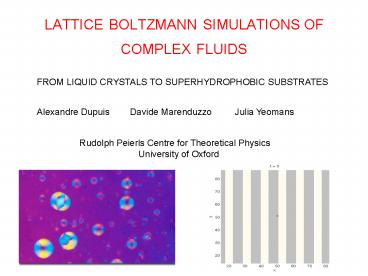LATTICE BOLTZMANN SIMULATIONS OF COMPLEX FLUIDS - PowerPoint PPT Presentation
Title:
LATTICE BOLTZMANN SIMULATIONS OF COMPLEX FLUIDS
Description:
FROM LIQUID CRYSTALS TO SUPERHYDROPHOBIC SUBSTRATES ... Energy from pressure gradient balances dissipation from director rotation ... – PowerPoint PPT presentation
Number of Views:356
Avg rating:3.0/5.0
Title: LATTICE BOLTZMANN SIMULATIONS OF COMPLEX FLUIDS
1
LATTICE BOLTZMANN SIMULATIONS OF COMPLEX FLUIDS
FROM LIQUID CRYSTALS TO SUPERHYDROPHOBIC
SUBSTRATES
Alexandre Dupuis Davide Marenduzzo
Julia Yeomans
Rudolph Peierls Centre for
Theoretical Physics
University of Oxford
2
molecular dynamics
stochastic rotation model dissipative particle
dynamics
3
lattice Boltzmann computational fluid dynamics
experiment
simulation
4
The lattice Boltzmann algorithm
eilattice velocity vector i1,,8 (i0 rest) in
2d i1,,14 (i0 rest) in 3d
Define a set of partial distribution functions, fi
Collision operator
Streaming with velocity ei
5
The distributions fi are related to physical
quantities via the constraints
The equilibrium distribution function has to
satisfy these constraints
mass and momentum conservation
The constraints ensure that the NS equation is
solved to second order
fieq can be developed as a polynomial expansion
in the velocity
The coefficients of the expansion are found via
the constraints
6
Permeation in cholesteric liquid crystals Davide
Marenduzzo, Enzo Orlandini Wetting and Spreading
on Patterned Substrates Alexandre Dupuis
7
Liquid crystals are fluids made up of long thin
molecules orientation of the long axis
director configuration n
1) NEMATICS Long axes (on average) aligned n
homogeneous 2) CHOLESTERICS Natural twist
(on average) of axes n helicoidal
Direction of the cholesteric helix
8
The director field model considers the local
orientation but not the local degree of
ordering This is done by introducing a tensor
order parameter, Q
ISOTROPIC PHASE
q1q20
3 deg. eig.
q1-2q2q(T)
UNIAXIAL PHASE
2 deg. eig.
q1gtq2?-1/2q1(T)
3 non-deg. eig.
BIAXIAL PHASE
9
Free energy for Q tensor theory
bulk (NI transition)
distortion
surface term
10
Beris-Edwards equations of liquid crystal
hydrodynamics
1. Continuity equation
2. Order parameter evolution
coupling between director rotation flow
molecular field -dF/dQ
3. Navier-Stokes equation
pressure tensor gives back-flow (depends on Q)
11
A rheological puzzle in cholesteric
LC Cholesteric viscosity versus temperature from
experiments Porter, Barrall, Johnson, J. Chem
Phys. 45 (1966) 1452
12
PERMEATION W. Helfrich, PRL 23 (1969) 372
helix direction
flow direction
Helfrich Energy from pressure gradient balances
dissipation from director rotation Poiseuille
flow replaced by plug flow Viscosity increased
by a factor
13
BUT What happens to the no-slip boundary
conditions? Must the director field be pinned at
the boundaries to obtain a permeative flow? Do
distortions in the director field, induced by the
flow, alter the permeation? Does permeation
persist beyond the regime of low forcing? How
does the channel width affect the flow? What
happens if the flow is perpendicular to the
helical axis?
14
No Back Flowfixed boundaries free boundaries
15
Free Boundariesno back flow back flow
16
These effects become larger as the system size is
increased
17
Fixed Boundariesno back flow back flow
18
Summary of numerics for slow forcing
- With fixed boundary conditions the viscosity
increases by 2 orders of magnitude due to
back-flow - This is NOT true for free boundary conditions in
this case one has a plug-like flow and a low
(nematic-like) viscosity - Up to which values of the forcing does permeation
persist? What kind of flow supplants it ?
19
z
y
Above a velocity threshold 5 ?m/s fixed BC,
0.05-0.1 mm/s free BC chevrons are no longer
stable, and one has a doubly twisted texture
(flow-induced along z natural along y)
20
Permeation in cholesteric liquid crystals
- With fixed boundary conditions the viscosity
increases by 2 orders of magnitude due to
back-flow - This is NOT true for free boundary conditions in
this case one has a plug-like flow and a low
(nematic-like) viscosity - Up to which values of the forcing does permeation
persist? What kind of flow supplants it ? - Double twisted structure reminiscent of the blue
phase
21
Lattice Boltzmann simulations of spreading
dropschemically and topologically patterned
substrates
22
Free energy for droplets
bulk term
interface term
surface term
23
Wetting boundary conditions
Surface free energy
Boundary condition for a planar substrate
An appropriate choice of the free energy leads to
24
Spreading on a heterogeneous substrate
25
Some experiments (by J.Léopoldès)
26
LB simulations on substrate 4
- Two final (meta-)stable state observed depending
on the point of impact. - Dynamics of the drop formation traced.
- Quantitative agreement with experiment.
Simulation vs experiments
Evolution of the contact line
27
Impact near the centre of the lyophobic stripe
28
Impact near a lyophilic stripe
29
LB simulations on substrate 4
- Two final (meta-)stable state observed depending
on the point of impact. - Dynamics of the drop formation traced.
- Quantitative agreement with experiment.
Simulation vs experiments
Evolution of the contact line
30
Effect of the jetting velocity
Same point of impact in both simulations
With an impact velocity
t0
t20000
t10000
t100000
With no impact velocity
31
Base radius as a function of time
32
Characteristic spreading velocityA. Wagner and
A. Briant
33
Superhydrophobic substrates
Öner et al., Langmuir, 16, 7777, 2000.
Bico et al., Euro. Phys. Lett., 47, 220, 1999.
34
Two experimental droplets
He et al., Langmuir, 19, 4999, 2003.
35
Substrate geometry
qeq110o
36
A suspended superhydrophobic droplet
37
A collapsed superhydrophobic droplet
38
Drops on tilted substrates
39
A suspended drop on a tilted substrate
40
Droplet velocity
41
Water capture by a beetle
42
LATTICE BOLTZMANN SIMULATIONS OF COMPLEX FLUIDS
- Permeation in cholesteric liquid crystals
- Plug flow and high viscosity for fixed boundaries
- Plug flow and normal viscosity for free
boundaries - Dynamic blue phases at higher forcing
- Drop dynamics on patterned substrates
- Lattice Boltzmann can give quantitative agreement
with experiment - Drop shapes very sensitive to surface patterning
- Superhydrophobic dynamics depends on interaction
of contact line and substrate
43
Some experiments (by J.Léopoldès)































